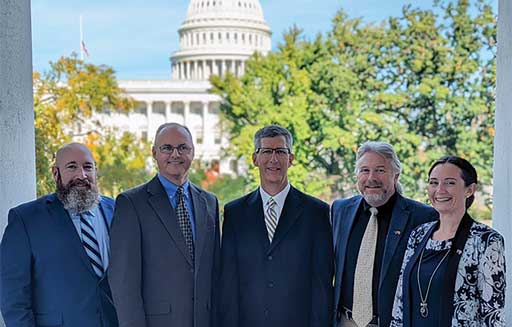The AASV Executive Committee members Drs Mike Senn, Bill Hollis, and Locke Karriker, joined Dr Harry Snelson, AASV executive director, and Dr Abbey Canon, AASV director of public health and communications, October 24-26, 2023 in Washington, D.C. The group joined the American Association of Bovine Practitioners (AABP) leadership for an annual visit hosted at the American Veterinary Medical Association (AVMA) Government Relations Division (GRD) headquarters.
The purpose of the trip was to provide AASV leadership with an opportunity to interact with federal regulators, government agency personnel, and legislators to discuss issues of concern to swine veterinarians. In addition, the Executive Committee heard from the National Milk Producers Federation (NMPF) and the American Association of Veterinary Medical Colleges (AAVMC).
The AVMA GRD staff welcomed the group and provided an overview of current federal and state legislative advocacy activity. Federally, five registered lobbyists advocate for animal health and veterinary medicine on behalf of veterinarians and the AVMA. At the state level, the AVMA GRD’s role is to monitor state activity and support state veterinary medical associations and allied organizations. For example, 19 states have considered or are considering legislative action on xylazine this year, many states have taken positions on the veterinarian-client-patient relationship and telemedicine, and multiple states have deliberated legislation on mRNA vaccine technology or product labeling. The AVMA summarizes state legislative activity each month at avma.org/advocacy/state-legislative-updates.
Leaders of AASV and AABP seized an opportunity to ask questions and share concerns with Food and Drug Administration (FDA) Center for Veterinary Medicine representatives Drs William Flynn and Tristan Colonius. Participants engaged in lengthy discussion about supply chain issues for animal health products, such as ponazuril and penicillin. Both organizations suggested more outreach would be needed as retail stores near depletion of products now requiring veterinary prescription under Guidance for Industry #263. They also voiced concerns about the risk of losing veterinary products as drug sponsors respond to the draft guidance on defining durations of use; FDA reassured their goal is not to lose product. In fact, FDA showcased the recently published Animal and Veterinary Innovation Agenda as a potential pathway to bring more veterinary products to market.
John Sagle, US Customs and Border Protection (CBP), described activities of the agency’s 2700 employees at 186 ports of entry, including 189 Beagle Brigade canine teams. While the veterinarians’ interest was heavily centered around the importation of prohibited agriculture products and foreign animal disease prevention, Sagle also described illegal importation of other material items and the link to illicit drug smuggling and terrorism. Further, he expressed concern with researchers shipping and importing veterinary diagnostic samples and underscored the importance of appropriate notification, documentation, and CBP evaluation.
Dr Andy Maccabe and Mr Kevin Cain, AAVMC, described the current state of veterinary education, including the addition of several more veterinary schools. The group engaged in lengthy conversation about swine medicine curriculum at non-swine state schools and discussed recruitment and retention of individuals in rural and mixed-animal practice.
Dr Jamie Jonker, NMPF, described the FARM 5.0 program, estimating that 99% of dairy farms were enrolled in the program. Dr Kis Robertson Hale, USDA Food Safety Inspection Service, provided an update on violative residues. Dr Maggie Behnke, National Bio and Agro-Defense Facility (NBAF), briefed the group on the transition to Manhattan, Kansas. Read more about AASV’s interaction with NBAF in the 2023 November/December JSHAP issue.1
On Thursday, with assistance from the National Pork Producers Council, the AASV leadership traveled to Capitol Hill to meet with legislators to emphasize Farm Bill priorities for food-animal veterinarians and pork producers. Critical programs and top priorities for swine veterinarians in the Farm Bill are described as the “three-legged stool,” which includes the National Animal Vaccine and Veterinary Countermeasures Bank, the National Animal Health Laboratory Network, the National Animal Disease Preparedness and Response Program, and the National Veterinary Stockpile. Other priorities include increased authorization to $5 million for the Food Animal Residue Avoidance Databank and improving dog importation standards to prevent the introduction and spread of diseases impacting animal, including swine, and human health through the Healthy Dog Importation Act.

The AASV advocates for animal health and welfare, public health, and veterinary practice by providing scientific information to decision makers. For more information about Farm Bill priorities, including actions you can take to inform and influence decision makers, review the 2023 March/April JSHAP issue.2 All veterinarians can and should advocate for animal health and welfare.
References
*1. Canon A. AASV leaders tour the National Bio and Agro-Defense Facility [editorial]. J Swine Health Prod. 2023; 31(6):314-317. aasv.org/shap/issues/v31n6/v31n6advocacy
*2. Canon A. Farm Bill season [editorial]. J Swine Health Prod. 2023;31(2):103-105. aasv.org/shap/issues/v31n2/v31n2advocacy
* Non-refereed references.
Abbey Canon, DVM, MPH, DACVPM
Director of Public Health and Communications
